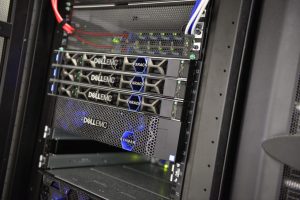Home »
After seven years of loyal service, the digital infrastructure of the Bravis Hospital was due for replacement. Head of IT & Automation Erwin Jansen and project manager and Qhubaan John Smits, together with the IT department, have taken on the task and can look back with satisfaction on a successful purchase and implementation of the new HCI from Dell EMC.
Erwin has a long track record within IT Management, he has been working in the healthcare sector for the past 5 years, the last 2.5 years of which he is permanently employed by Bravis. “Working in the healthcare sector is very rewarding. You see a lot more people here with a passion for their work, it’s nice that I can mean something to those people in my role. Moreover, there is still a lot of progress to be made in the field of digitization within the healthcare sector. I am happy that I can now make a positive contribution to this from my position.”
What is Hyper Converged Infrastructure?
The HCI, abbreviated for Hyper Converged Infrastructure, is a new approach to efficiently store large amounts of data and applications virtually and make them quickly available. HCI is a Software Defined Infrastructure that virtualizes all elements of conventional hardware-defined systems. So to speak, a plug and play solution in which storage, computing power and operating software go together in one box, straight into the server rack. With the successful implementation, Bravis is the first hospital in the Netherlands to use HCI.
Digital aggregation of Bravis locations

Bravis has two medium-sized locations in Roosendaal and Bergen op Zoom. There is a continuous data stream between the locations in which the two environments are replicated to and from each other. “In total, we are currently talking about a capacity of 150 Terabytes, which covers all the data we process. Think of photos, radiology, patient files and all office documents. All this data and applications were located on various infrastructures. With the new system we are preparing for a growth to a total capacity of 300 TB. In addition, everything is now moving step by step to one infrastructure, a major step in terms of speed, capacity and manageability.”
Plans for the physical merger of the two locations have been in the works for several years now. The decision has now been made where the new hospital will be located and it is expected that in 7 years the whole will be together at the recently chosen location. It was not possible to wait that long for a new digital infrastructure. The old system had been standing for 7 years and started to show signs of age in some parts. “In the previous period, we saw an increase in disturbances in some systems, especially in the environment in which the non-radiological images were stored and processed. There was a downward trend in availability on both hardware and software, so it was high time for modernization.” Analyzes Erwin. “Not entirely incomprehensible. Seven years is quite a long time for such a system in today’s IT landscape. During the implementation of the new system, we increasingly saw disruptions in the old system, so we should not have waited a year longer. Perfect timing in that regard!”
Approach transition to HCI
At the start of the process, John Smits started making an inventory of all the requirements and wishes of the stakeholders involved. “With a project like this, it is very important that we have a good overview of which parties have which needs. Those needs turned out to be quite clear. Our end users are healthcare professionals, they are not much interested in the technical content. The only really important pillars for them are speed and ease of use. From there we started looking at the more substantive requirements of our IT department. Controllability, effectiveness, redundancy and data efficiency were key concepts. Effective storage and data efficiency is not unimportant when you realize that some photos that are taken quickly cost 10 GB. A few departments are even now taking photos in 4K. The images will only become sharper in the coming years, so consumption will also increase. Storage and transaction must therefore be effective, for both the IT department and the end user.
It goes without saying that the systems must be redundant. Of course we cannot accept that we can no longer do our work due to a system failure, with all the associated risks. For similar reasons, effective management was therefore also an important point in the purchase. Because with the HCI solution the entire infrastructure runs virtually on one integrated system, troubleshooting is also made a bit easier.
How do you make the right choice for an HCI supplier?

Three parties responded on the basis of the written Program of Requirements. Dell EMC, HP and NetApp. In addition to the traditional solutions (Cloud, On Premise), HP and Dell EMC also presented the HCI solution. A fairly new solution that has already found its way to some extent in other sectors, but not yet in the more conservative healthcare sector. Logically, they wanted us to use the HCI as it is a step in the market. “That helped us in our negotiating position. Both John and our buyer did a good job in negotiating. We saved a lot on that and, moreover, with the agreed order of payment, we were able to overcome some irregularities that arose later in the project in advance and quickly rectify them. In any case, a sharp negotiation was not a superfluous luxury.
“The cooperation with Dell EMC has been pleasant so far. Of course, we cannot expect everything to run smoothly with such complex implementations and we had to discuss a number of issues up to the top of the tree. The way in which communication is then carried out and the agreements made are acted upon is very pleasant. This of course works both ways, for which I am very grateful to John. He has shown how you can also deliver a project within time and budget in a good way within the healthcare sector while all stakeholders involved are satisfied. Occasionally he had to get his teeth into it at Dell EMC, which he did very calmly and steadfastly”.
Bears on the road during implementation
That while not everything went smoothly. This became apparent at the start of the implementation. During the physical placement of the cabinets, the project ran into its first challenge. The cabinets are completely screwed together in Ireland and then shipped. Upon arrival, it turned out that the devices did not fit through the door of the server room. In the end, everything was taken apart on location and put back together in the server room. “Then you think you have taken everything into account.” Turns out that even for the most digital system, a carpenter’s eye is not out of place.
After the new components were installed, configured and connected, it was time to start the migration process, in which all intended applications and data are gradually transferred to the new HCI. During this process, it turned out that an incorrect ratio had been used to calculate the data compression. As a result, in practice less than 300TB became available. “It took quite a bit of effort to get Dell EMC to move along with this in what we wanted. Fortunately, we had gone to work well prepared. The contract was well prepared in advance and eventually Dell EMC acknowledged that it had made a miscalculation.”
The benefits of the new Hyper Converged Infrastructure
After Dell EMC made the full 300TB available, the surprising added value of the new system became apparent. More than previously intended, a much larger part of the total application landscape of the hospital could be loaded into the HCI. “That was a pleasant surprise indeed.” Erwin grins.
The transfer of a larger part of the application landscape also revealed the risk of the HCI when, due to an already known problem, an entire department could no longer access its applications. “Fortunately, this was quickly resolved and provided with an update to prevent the outage in the future. That was a bit of a shock, of course, but in the end it turned out to be a successful test case for manageability.”

Erwin is positive about the new HCI and the way the project went. “We have made significant progress on many fronts. The system is much faster, easy to manage and takes up a lot less space. We are also a lot more positive from a cost-technical point of view. Now only the last bit of completion remains, but I trust that Dell EMC will honor the agreements.” Erwin is clear about the possibilities of the HCI. “I would definitely recommend the HCI to all organisations. HCI fits in perfectly with the idea of Edge computing, as a successor to the movement to move everything to the cloud. HCI offers faster storage locally, and can be directly linked to slower storage in the cloud.”
What will the future hold for Bravis?
It is not yet clear what Erwin’s next major project will be. “In the coming period we will invest in the successful completion of the implementation of the HCI. This means full acceptance by end users and implementation of some latest software updates from Dell EMC. After that, there are still plenty of challenges to think of, such as expanding our patient portal to the clinical patient, fully automated data exchange with other healthcare institutions and a biosensor that we are applying together with Philips. An important factor in the coming years is the relocation of the hospital to one location. I am positive, we will see what the future brings!”
Want to read more about innovation at the Bravis hospital? Then also read Bravis hospital is data-driven
Looking for good project managers or solutions for your digital transformation? Please contact Sebastiaan Vlamings .
More information?
Sustainable Organisation Services

JESSICA VAN BEEK
Jessica.vanbeek@qhuba.com
+31 614749698
